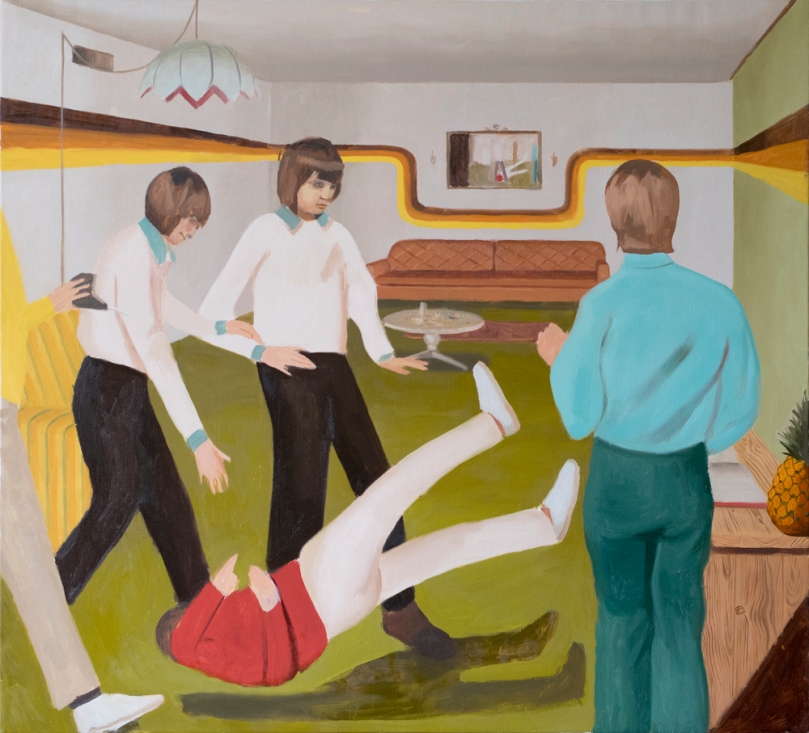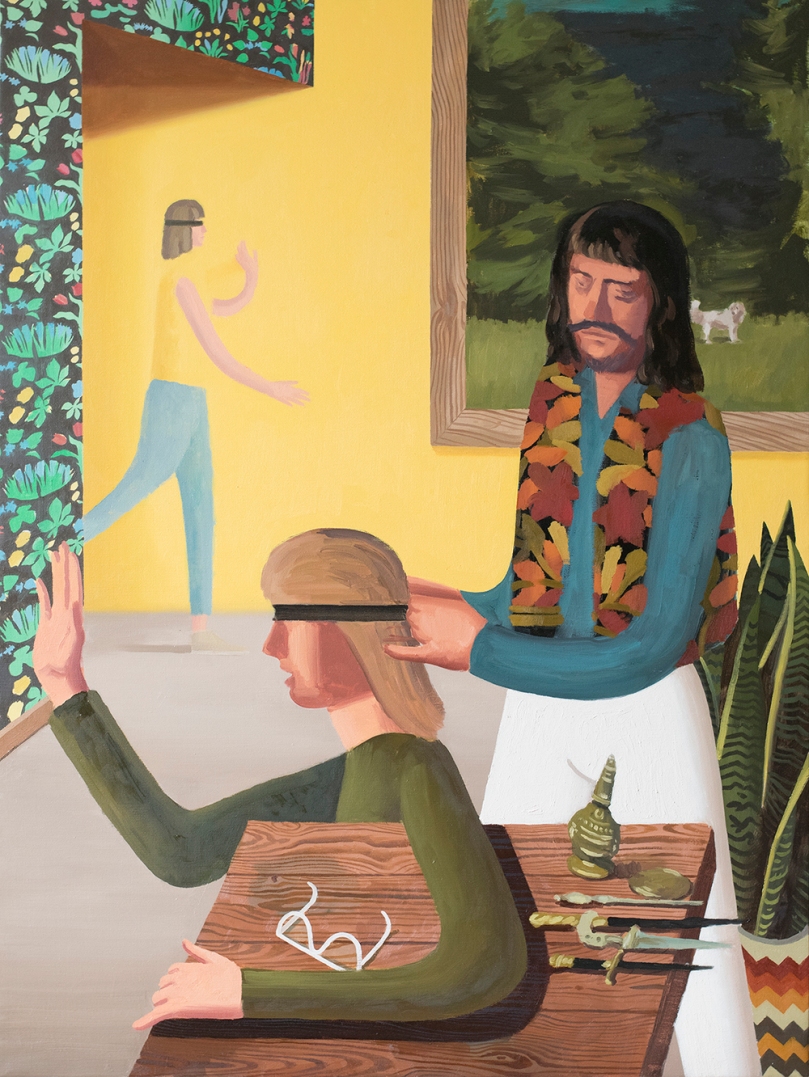AB: Sul-Jee and I have had the pleasure of going to school with you, which means we have seen your work evolve. At IU, your paintings were more academic and perceptual. Could you talk about how that foundation plays into your current body of work?

GB: The link has to do with visual problem solving. I remember measuring angles during Math class in high school. I was drawing my teacher’s head and I realized his nose corresponded with an angle, which I could compare with another one, and so on. It was like visual algebra and I became totally hooked on perceptual drawing and painting. I was really interested in Cezanne, how weird and hallucinatory things can seem after looking at them for an inordinate amount of time. I became obsessed with shapes, or seeing things as patterns of interlocking shape/tones. I started to look at figurative painters who used flatter forms, like Fairfield Porter. Painting from life became a game of finding shapes, be it within objects, through objects, through shadows, etc. – and how they added up into an image. So I started reducing and simplifying things into flat shapes, which are essentially the types of forms I am working with now. I have a great love for perceptual painting but I never felt as if I ever managed to really locate myself in it. In grad school I decided to stop talking myself out of ideas for paintings that seemed ridiculous. Like I wanted to make a painting of people getting pulled over while smoking weed in a car, so I just made it up. It forced me to think about painting in a totally different way. Making a painting without a direct reference let me explore content that I couldn’t approach before, like painting a falling figure or disembodied hands. I am still obsessed with interlocking shapes, but have become more interested in finding them through different processes. I still think of painting like solving a bizarre puzzle.

AB: In your statement you mention “the tragically mishandled situation.” How does this relate to the physical act of painting?
GB: All of my paintings get tragically mishandled at some point, sometimes on purpose. I usually start from collages or drawings and I often make them rough or incomplete so I have to resolve any issues while I am painting. Whenever I try to make really planned out preparatory work the painting itself becomes a transcription and then I have to fight against that. The painting closes up and I realize that the composition is bad, an element doesnt fit, or something along those lines. Laziness in color mixing is an ongoing battle for me, since I use a fairly limited palette and sometimes go on autopilot. Ill lay something in like a drawing and then have to repaint it later. All in all I think some errors and missteps along the way are good for the work, because I can react to them and unexpected things happen.

SJ: SJ: Many of your recent paintings make use of a late 70’s/early 80’s aesthetic that feels particularly suburban — it seems like you have an earnest appreciation for the clothing and the more bizarre interior design trends of the time. Could you tell us more about how you decide upon these kinds of visual details — like, why bellbottoms?
GB: I love all the tans and solid linear shapes of that period. Although I grew up after the heyday of those trends, some of them lingered around my childhood haunts: the bowling alleys and roller rinks of my youth. The house I lived in had a bit of a retro vibe and I think that really stuck with me. I grew up in the suburbs of New York which had a wide variety of fading design trends, and I like the idea of living contemporaneously amongst them. Part of it is remembering things from when I was very young and that is kind of mysterious for me. Otherwise, I like de-saturated flat shapes, which are basically what faded photographs from that period look like.


SJ: What role does time play in your work? Both the era in which you see your paintings being set as well as the concept of time as a regulator of experience — its role in navigating the unknown, etc.
GB: I try to time the experience (my own at least) in two layers. The first happens all at once, the second is found if I can stay in it long enough. There is an initial reaction to seeing something, like a snap judgment – so it has to hold attention from the start. For me this is the design. Afterward, the unknown or ambiguity comes in, with the subject. I try to leave room for interpretation even though I may have secret narratives going on. The paintings seem to take place a step removed from our time, which allows me to paint about things that don’t seem so direct to my own experience. I reference a lot clothing and décor from the 1960’s through the 1980’s. It was pre-internet time. I like the idea of having knowledge be less accessible than it is today. We can find out almost anything instantly, which is amazing but perhaps does a disservice to magical thinking and slow and painful self-discovery. I cherry-pick aesthetics but I try not to place things too squarely in any one period. Contemporary styles still reference that time, so I like to think they are both referential while still being plausibly contemporary scenes. I used to raid my grandpa’s closet growing up. I still dress like that sometimes.

SJ: Favorite 70’s style icon?
GB: Shelley Duvall and Jack Nicholson in The Shining.

AB: What’s your favorite studio snack?
GB: These Stella D’oro breakfast cookies, the S shaped kind. They are modest cookies but go very well with coffee.


[…] Check out Greg Burak’s interview with us here: https://commandzine.com/2016/11/24/greg-burak-interview/ […]
LikeLike
[…] it doubled over. I took the sack out of the trash and pinned it on the wall alongside paintings by Greg Burak and Maddy Winter. On the wall the sack had transformed – undistracted by its utility, I could […]
LikeLike